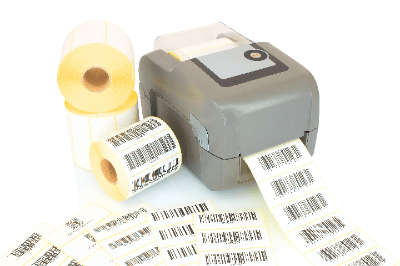What Is a Barcode Printer?
 A barcode printer is a machine that prints barcodes, which are bar and number representations of various types of information, on a specific sheet of paper.
A barcode printer is a machine that prints barcodes, which are bar and number representations of various types of information, on a specific sheet of paper.
A bar code contains 13 numbers. The first two digits are the country code, the next seven digits are the manufacturer code, and the next three digits are the item code. The last digit is a code used for reading confirmation. This code is used to prevent errors.
Uses of Barcode Printers
Barcode printers are used to print barcodes, indicating product information on various products. Barcodes contain information such as lot numbers, product information, and prices of industrial products.
Because barcodes are used in many different situations, barcode printers have a very wide range of applications.
Principle of Barcode Printer
The principle of a barcode printer depends on its printing method. There are various types of barcode printer printing methods, which can be broadly classified into the following five types.
1. Impact Method
The impact method can be further classified into “drum impact method” and “wire dot impact method.”
Drum Impact Method
The drum impact method is a conventionally used method. A barcode character, which forms a barcode pattern, is engraved on the outer circumference of the printing drum in advance, and the pattern is transferred by crimping the drum to a backing paper. However, this method is not widely used these days due to issues such as complicated maintenance.
Wire Dot Impact Method
The wire dot impact method uses the same principle as the impact printer used in ordinary OA printers to perform printing. Pressure is applied to the part of the ink ribbon of the printer that corresponds to the Barcode Printer’s pattern, and the pattern is transferred to the backing paper. This method is still used today because of its low running cost.
2. Thermal Method
In the thermal method, a heat element that represents the barcode pattern, called a “thermal head,” is built into the print head, which is heated to print the barcode.
The thermal paper is placed in contact with the print head, and when an electric current is applied to the heat element only during barcode printing, the barcode pattern is printed on the thermal paper.
Since the thermal paper on the side to be printed directly changes color, the system does not require consumables such as ink ribbons, which are necessary for general printing methods, and thus can be operated at low cost. Currently, most barcodes in the food industry are printed using this method.
3. Thermal Transfer
The thermal transfer method is similar to the thermal method. While the thermal method uses thermal paper, the thermal transfer method prints by inserting an ink ribbon between the thermal head and the backing paper.
When an electric current is applied to the thermal head, only the portion of the ink ribbon that corresponds to the pattern of the thermal head melts and adheres to the backing paper, resulting in printing. With this method, printing is possible not only on paper, but also on polyester, vinyl chloride, aluminum foil, etc.
4. Electrostatic Method
The electrostatic method uses the same principle as that used in photocopiers (PPCs) for office automation equipment to print barcodes. An electrostatic print image is formed on the photosensitive drum in accordance with the barcode pattern, and toner adheres to this print image. This toner is then transferred to the backing paper.
The same principle as that of a photocopier in office automation equipment is used, enabling high-quality, high-density printing.
5. Inkjet Method
The inkjet method uses the principle of inkjet printers to print barcode printers. In other words, barcodes are expressed by controlling ink irradiated at high speed from the ink nozzles of the print head through the gap between the deflector plates to the desired printing location.
The inkjet method is inexpensive to run because ink is printed directly on paper or other substrates. Another feature of inkjet printers is that they can also print directly on plastics, metals, glass, etc. other than paper.
Other Information on Barcode Printers
1. Handy Type Barcode Printer
Barcode printers are also available in handy and portable types, such as thermal and inkjet printers.
These printers can read information from PCs, smartphones, tablets, etc., and print barcodes on the spot. Barcodes can be issued on the spot in warehouses and other locations, contributing to improved work efficiency and the prevention of human error.
2. Points to Keep In Mind When Using This System
Depending on the period of time for which barcodes are to be affixed, it is necessary to distinguish between thermal and thermal transfer systems. Thermal barcode readers use thermal paper. Therefore, if the barcode is attached for a long period, the thermal paper itself will be tarnished and the barcode will become difficult to read.
Therefore, a thermal transfer barcode printer is recommended if the barcode is to be affixed for a long period of time. Thermal transfer barcode printers print by thermal transfer of ink from the ink ribbon onto the backing paper, so the color will not burn even if the barcode is attached for a long period. If the barcode application period is not long, a thermal barcode printer is recommended because it does not require an ink ribbon and is low cost.